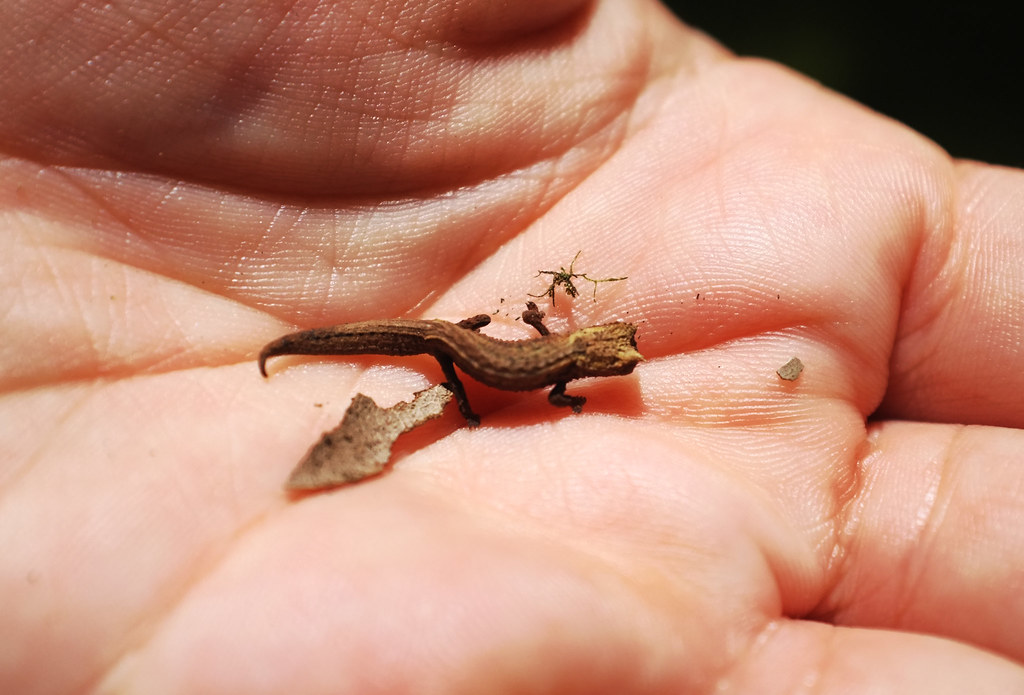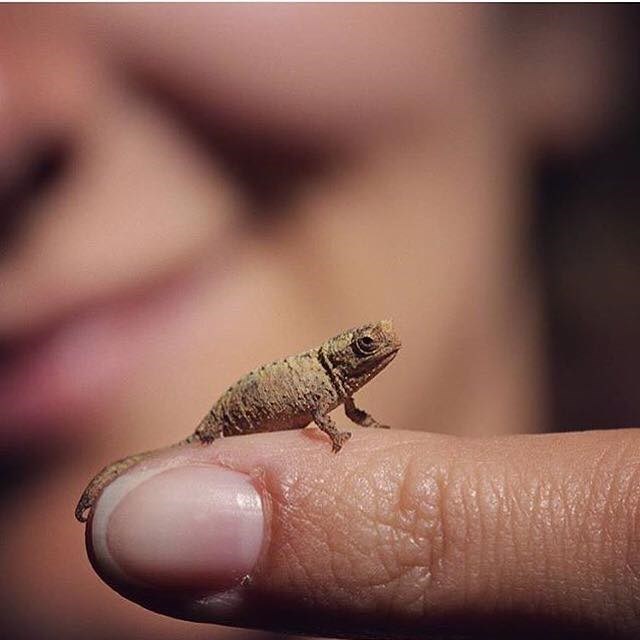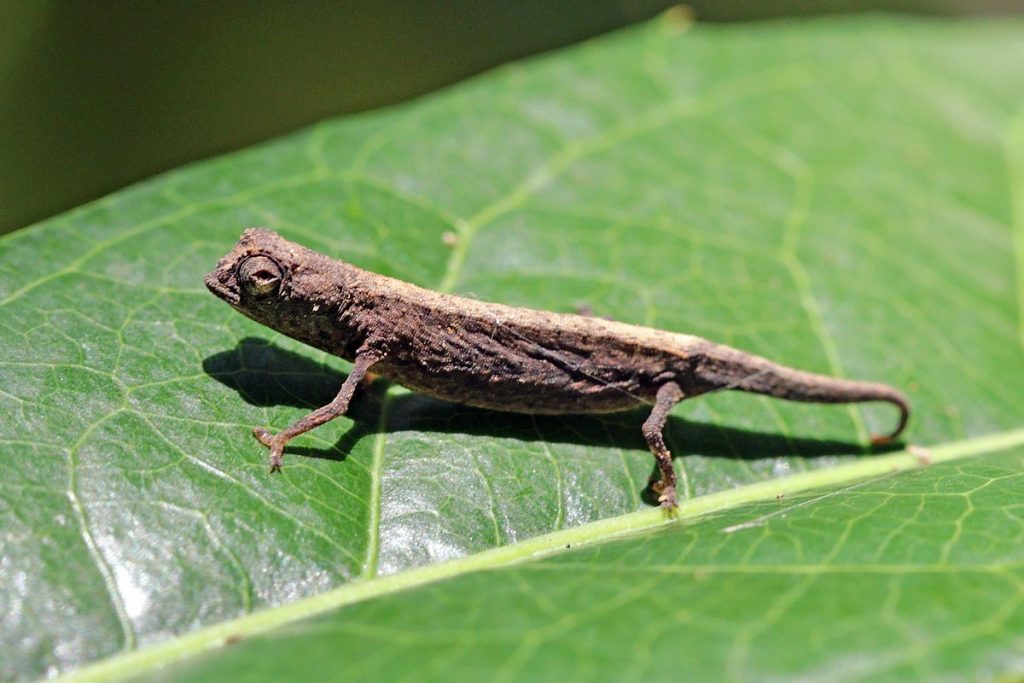The Brookesia Micra is one of the smallest reptiles in the world. Frank Rainer Glaw discovered it, a German herpetologist working at the Zoologist. The Brookesia Micra, also known by the name Nosy Hara leaf chameleon.
Brookesia is the Scientific symbol, and “Micra” is their call name. B. Micra shares its living area with other species of chameleons Family, such as Brookesia nana. Stick with the content if you want to know more about this Chamaeleonidae.
Brookesia Micra

The name “Brookesia Micra” was given by German Herpetologists Frank Glaw, Köhler & Vences in 2012. But it was discovered in 2005. At first, Glaw named it “Brookesia sp”. In 2007, Glaw and Vences changed it to “Nosy Hara”.
The B. Micra has the ability to change its color, particularly under stress. A stressed chameleon develops a pale stripe down its back, and the body turns dark brown.
It has a consolidated body, a twisted tail, bulged eyes, and a long projectile tongue that allows the chameleon to grasp objects. Their eyes move independently of one another so they can easily see more than one place at the same time.
The pygmy leaf chameleon is also known as Brookesia minima; they are also an inch long. They are also closely related to the Micra, but more on it later.
The Reproduction and Lifespan of Brookesia Micra
Brookesia Micra is the smallest known chameleon found on the island of Madagascar. First-time chameleon Chameleon the world got to know it back then in 2005. It was uncovered by a group of researchers led by German herpetologist Frank Rainer Glaw, a German herpetologist.
Reproduction and life cycle scientists don’t know much about the breeding habits of Brookesia Micra. They think that the procedure is inner. After breading, The female excavates a hole where she will lay a minimum of 2 eggs.
The eggs are massive compared to the size of their mum. The female lays the eggs and covers them. Then leaves them to their destiny. After 90 days later, the eggs hatch, and the newborns are autonomous from their 1st day.
A captive Brookiesia Micra can have a lifespan of about 10 years but the number doesn’t tell the unknown story of their lifespan in the wild. (Source)
The Lifespan in the Wild of Brookesia Micra

At first, The incredible B. Micra was named Broolesia SP in 2005. Then in 2012, Sir Frank Glaw renamed it “Nosy Hara”. Many people get tangled with these two dates, that’s I try to make it neat and clean.
Now coming to the main point, many people are curious about their lifespan in the wild. So, their no official state meant about this lizard. But, one of the research team-mates disclosed that, as they have been working on them from 2005 to the present, they came to an estimate that can increase or decrease from time to time.
They assume with their collected data that a Brookesia Micra has an estimated lifespan of about 6 years in the wild. But still not sure how long they can live in the wild.
Chameleons’ Habitat and Diet
Brokesia Micra, also known as leaf chameleon and Nosy Hara chameleon. Biologists believe that insular dwarfism is responsible for its tiny size. The small size and the need for limited space allow it to get by with fewer pro vendors and become sexually mature earlier.
B. Micras have 20 vertebrae compared to the 50 vertebrae of bigger chameleons. The chameleon turns pale grey at night as it roosts in trees. Strangely this makes them much easier to see behavior during the day.
On the tiny island of Nosy Hara, which sits off the coast of Madagascar, the Nosy Hara Chameleon can be seen in the leaf litter of the arid karstof the forest. The leaf litter is where it hunts for prey at night; it climbs into a tree at a height of about four inches. The lizard mainly eats small insects like ants and others.
Unbelievable Brookesia Micra Facts That You Never Know

Frank Rainer Glaw and his group of researchers find this beautiful creature. B. Micra is one of those small lizards only available on Madagascar’s northwest coast.
They are deeply connected with their nature and habitat, but researchers don’t know enough about them from their discovery to now. However, We have learned so far that you will be surprised to know. So, let’s on it;
- Unlike larger chameleons, the Brookesia Micra’s tail is stumpy and not prehensile. Instead, it uses its tail as a fifth leg to climb up trees.
- They are only found in the Nosy Hara in Antsiranana and are heavily attached to its temperature and humidity.
- The Leaf Chameleon is a ground reptile that moves about the duff on the wild floor in the day, heights and cracks to escape from predatory conditions, warmth, and bad weather, and climbs a few inches into the trees to rest during the night.
- Brookesia Micra has 20 vertebrae compared to the 50 vertebrae of bigger chameleons.
- It is said that the B. Micra would be the least vertebrae chameleon till now in the world.
- The chameleon turns pale grey at night as it roosts in trees; strangely, this makes them much easier to see.
- When they feel frightened, the reptiles Reptiles can let go of their perch and fall or simulate the vibration of a dead leaf.
- An adult Leaf Chameleon can reach a length of 29 mm or 1.1 inches.
- Brookesia Micra can curl up and act like a dead leaf when endangered.
- They catch insects and other small things with the help of their long tongues.
How Many Brookesia Nana Are There?
The Brookesia Nana, or nano-chameleon, is among the smallest chameleon species which is native to Madagascar. It is the most miniature reptile in the world, as uncovered in 2021 by Frank Glaw.
Nano-chameleon is brown in color and does not change color like other chameleon species.
Male adult body length, including the tail, is 22 mm or 0.87 inches, whereas the female length is significantly longer at 29 mm or 1.1 inches. The Males tend to be slightly smaller than the females, but the reason behind this is still unknown to experts.
The quantity of nano-chameleon in existence is unknown. They are a tiny species of chameleon that can only be found in a limited portion of Madagascar. They are uncommon, and it is believed that their population is dwindling.
Are Pygmy Chameleons Good Pets?
The Pygmy Chameleon is also known as the African leaf chameleon and is one of the species of chameleons. Like others, most of them come in grey, brown, or green colors.
Their average length is about 3 to 4 inches long from nose to tail, and they are primarily seen in central East Africa. As B. Micra’s pet trade is illegal, numerous breeders sell pygmy leaf chameleons by saying it B. Micra.
However, a pygmy chameleon is a good pet, and they don’t require any large enclosed like others. But still, it needs to be dealt with very carefully when you are a pet owner.
So keep that in mind. And before purchasing, you need to conduct research to find a good breeder to get a healthy chameleon. Their diet, such as house flies, butter worms, mealworms, etc, is also essential to keep nutritious.
How Much Do Pygmy Chameleons Cost?
So many people may think or decide to buy the B. Micra. But B. Micra is not for sale and should not be purchased for any price.
It is uniquely adapted to its natural habitat, which may be impossible for a layperson to replicate. However, you can’t buy a bee micro chameleon because they aren’t legally offered as pets.
People sometimes try to sell pygmy chameleons as b micro chameleons; the price of these reptiles can be as low as 25 or over 200 dollars for one specimen.
Conclusion
In the end, through this article, we learn about Brookesia Micara, Nana, and minima, their habitats, the story behind their discovery, some unknown facts, and clear other confusion.
It will help you know these beautiful creatures effectively and give you a glance at our knowledge compare to the depth of nature.
The main purpose of this content is to let you be curious to get more knowledge and get more knowledge from this massive repository of knowledge.
Hugues Beaufrere is the Exoticpetia’s senior writer and reptile expert. He has been fascinated by reptiles and monkeys since he was a kid and had years of experience in herpetology and primatology. He has cared for various kinds of Monkeys, Lizards and Reptiles and loves to share his knowledge and passion with others.


